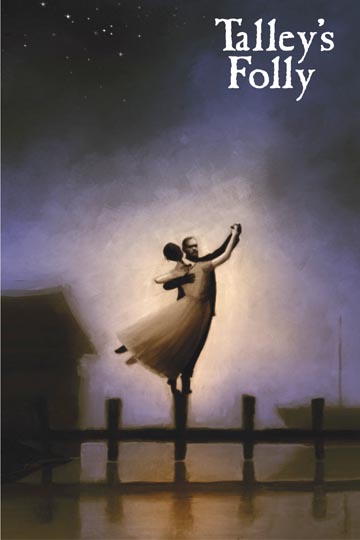|
Theater
Reviews
A
Waltz to Remember

PASADENA,
CA - The Talley family boathouse is a poignant ruin, charmingly
forgotten, a Victorian valentine piled with debris and crumbling
under a shaggy canopy of maples.
As the sun goes down its timbers turn to copper, and
later in bluish moonlight its gingerbread shadows are stark and
a little scary, but winking just so with fireflies. The neighbor's dog woofs pleasantly on command, and also
right on cue, the town band from across the river will strike up
a brassy arrangement of the very song our hero has just crooned
to his protesting lady love.
In
Lanford Wilson's Talley's Folly, the artifice is
evident even before the houselights go down, as one of its two
characters strolls onstage to "point out the
facilities," provide some background on the wartime
setting, and warn us that the play lasts ninety-seven minutes
with no intermission, so maybe we should be thinking about
getting a drink of water. He also tells us we're about to see a romance--a
"waltz"—and that the trees, the band, the crickets,
and "this rotating gizmo in the footlights"--the
watery moonlight effect-- are all there to help him.
Help him what? It's
not immediately clear. But
the man is nervous, expectant.
He doesn't stop babbling to the audience until a woman's
voice, offstage, approaching, calls his name.
Then he seems afraid.
Everything is already at stake as the houselights
suddenly dim, the sunset kicks in, and somebody turns on the
crickets.
The
artifice --- the magic --- hits full stride, and Matt and Sally begin
their “waltz.”
|
|
Why
does it work? We have already seen the man behind the curtain.
Why do we care, why do we laugh, why do we ache over
Matt’s desperation, Sally’s wounded spirit? Why are we anxious each time Sally threatens to leave—as if
anyone could be absent for long in a two-character play?
Why do we ride so happily this ninety-seven minute roller
coaster of contrivance and coincidence until the foregone
conclusion of a happy ending makes its appearance, right on
schedule, with an almost audible pop.
I don’t know why.
I don’t think Lanford Wilson knows why.
But he knows how. All the skill it takes to make that kind of thing happen is
at his command. He
takes a kind of wicked pleasure in knowing that an audience will
jump through hoops to get to the magic.
Wilson doesn’t ask us to suspend our disbelief.
He hoses us down with it, then dares us not to.
And we do. We
can’t not.
Talley's
Folly is that full of wisdom, comedy, tears,
romance--pretty much everything we go to the theatre to
experience. And at
the Pasadena Playhouse, as you might expect, Wilson's Pulitzer
Prize-winning script is in the hands of masters.
The poignant boathouse, for example (scenic design by D
Martyn Bookwalter) may just qualify this as the prettiest Talley's
Folly ever. Dennis
Parichy was Lighting Designer for the original New York
production of the show, and his work here is painterly and
fluid, unafraid of sudden change, and unafraid of the dark.
Director
Andrew Traister, long associated with co-producing Arizona
Theatre Company, moves his actors naturally at times,
artificially at others-- his choices always justifiable, I
think. He's located
some pauses in the dialog--lengthy at times--that are so right
they take your breath away. But
Mr. Sound Designer, having spent many a summer night in
Missouri, I have one word for you: Cicadas.
When
so many behind-the-scenes artists have brought so much skill and
care to their contributions, it isn't quite fair that the
actors' work will be hardest to forget. But that just
means they got the balance right. Angela
Reed as Sally must somehow be both transparent and mysterious,
and she is. With
far less to say than the desperately garrulous Matt, her
reactions must be small but packed.
I don't remember ever spending so much time watching a
character who isn't talking, but listening.
|
|
Everybody's happiness depends on Sally's reactions.
But Ms Reed slyly gives it all away when, while
alternately threatening to leave and ordering poor Matt to go
home, her Sally sits down on a dusty bench leaving ever
so much room for Matt to sit beside her.
The
role of Matt was originally written for the actor Judd Hirsch,
and Michael Santo, without giving us an impersonation, isn't
afraid to bare his inner Judd. Also
impressive is that although the character Matt is supposed to be
funny for the sake of our entertainment, and trying to be funny
for the sake of his reluctant lady, you never catch Michael
Santo trying to be anything but Matt.
At
the start, talking to the audience, he seems a bit ill-at-ease.
It crosses our minds that perhaps we're not in the most
skillful of hands. But
it's clear soon enough that this is not Mr. Santo's awkwardness.
It's Matt's.
Like
so much in this piece, what seems odd or off-putting is almost
certainly that way for a reason.
The writer, the director, the players have thought it out
so fully, through so many levels, and with such affection, that
it all just works. It
holds up under our closest scrutiny, and rewards any amount of
re-examination with new flashes of discovery--resonance,
parallels, ironies--that remind us why we go to the theatre.
Talley's
Folly
at the Pasadena Playhouse is a magic trick with the wires
in plain sight, and still we go home astonished. - G. R. White
printable
view
For
Ticket Information:
www.pasadenaplayhouse.org/
|